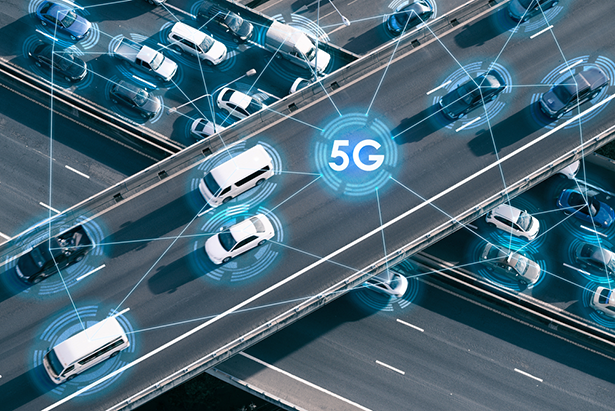
How 5G Standards Will Impact Driving and Autonomous Vehicles
Observers of the automotive industry have long predicted that 5G (5th-generation) communications will have the ability to greatly advance autonomous driving and the adoption of autonomous vehicles (AVs).
In short, 5G is an ultra-fast, ultra-reliable, ultra-low-latency signal that has the potential to be 100 times faster than the previous standard, 4G (4th-generation), by using higher spectral efficiency, advanced mobile technology and newer network architecture. 5G can handle bandwidth as high as 20 gigabytes per second (Gbps), whereas 4G is limited to speeds of around 100 megabytes per second (Mbps).
5G Will Allow Advanced V2V and V2X
5G will allow new forms of vehicle-to-vehicle (V2V) communications so that in the future, two cars approaching from directions that are perpendicular would allow their onboard computers to determine which vehicle will yield for the other one at the location where their paths will cross.
With vehicle-to-everything (V2X) communications, cars will be able to communicate with objects, pedestrians and traffic management systems (TMS) at intersections. This will allow for great advances in safety because cars will be able to sense hazards much farther in advance and use automated systems to apply brakes, accelerate or steer where necessary. Stoplights at intersections will be able to detect cars approaching from opposite directions and be able to change their lights intelligently. Cars will be able to sense pedestrians from the signals being emitted by their smartphones. And objects will be able to transmit signals to cars that will guide the vehicles around them.
V2V and V2X will effectively allow cars to “see” around corners. No longer will drivers feel the need to speed through stoplights to gain time. In fact, if standards like 5G are used efficiently, it may be possible to significantly reduce the number of stoplights, stop signs and stopping of vehicles in general. All of these have tremendous positive implications for safety.
Other 5G applications include utilization in advanced driver assistance systems (ADAS), infotainment devices (equipment for entertaining and informing vehicle drivers and passengers), automated valet parking (AVP), autonomous truck platooning (allowing trucks to drive in tightly spaced single-file configurations) and bandwidth-heavy uses such as connected ambulances, wherein doctors will be able to perform emergency surgeries en route to hospitals using virtual reality (VR)-connected robotic hardware.
5G Will Enable Advanced C-V2X
While the desire for V2V, V2X and other capabilities is strong, the standards they will be based on are still up in the air. The technology that 5G will drive specifically is cellular V2X (C-V2X). C-V2X is bi-directional, has a range of up to 1,000 meters and uses cloud-based sensor sharing. Utilizing 5G for C-V2X is appealing because the latency time (how long a device has to wait for a signal) is extremely fast — four milliseconds or less. This compares to 4G Long-Term Evolution (LTE) standards, which have a latency time of 15 milliseconds or less.
In a city center, where traffic is dense, there can be millions of vehicles, objects and people all interacting concurrently, so a communications network needs all the speed it can get. It also needs a dense grid of base stations or towers from which the communications signals can be broadcast. For now, C-V2X standards are based on LTE, but there are plans to advance these to 5G in the near future.
5G for autonomous vehicles will be rolled out first on highways, then in cities — places where it can be taken advantage of immediately. But in order for this to happen, multiple stakeholders — automakers, chipmakers, equipment manufacturers, regulators and mobile operators — will need to agree on 5G standards for disparate marketplaces.
Antenna & Wireless Technology for 5G
Antennas for 5G are generally more compact than those for previous cellular signals while being higher-precision and lower-latency. Because 5G uses more intelligent power switching depending on how much bandwidth is being used, it makes better use of beamforming, an active antenna technology that employs directional radio links to supply high bandwidth to mobile devices selectively and simultaneously.
5G antennas and wireless modules allow for massive multiple input-multiple output (MIMO) systems for targeted radio contact between 5G transmitters; in the newest three-dimensional (3D)- and massive-MIMO devices, several transmitters and receivers operate within one terminal unit. Better beamforming and MIMO allow for faster data transmission.
Many 5G antennas are backward-compatible with 4G LTE signals. While most 5G car antennas look similar to 4G antennas (while being smaller, and, in some cases, slimmer), some Japanese and European manufacturers have run high-speed tests with 5G antennas mounted in windshield glass that have the potential to be nearly invisible in future vehicles. Contact our engineering team to discuss custom wireless capabilities for your next vehicle designs.

